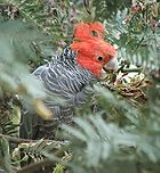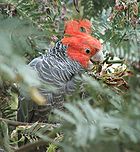
Ngunnawal language
Encyclopedia
Ngunnawal or Ngunawal is an Australian Aboriginal language, the traditional language of the Ngunawal people.
dialect area that covers the limestone plains of Monaro
/Maneroo in NSW to ACT across the Monaro
tableland through to the Australian Alps
of NSW/VIC Snowy Mountains
. It falls within the Yuin–Kuric group of the Pama–Nyungan family.

Classification
Ngunawal is currently classified as a sub-tribe of the larger Ngarigu/NgarigoNgarigo
The Ngarigo is the Aboriginal people group whose traditional lands lie south-east of the Canberra area.According to Norman Tindale in his 1974 catalogue of Australian Aboriginal people groups, the specific areas lands of the Ngarigo are:...
dialect area that covers the limestone plains of Monaro
Monaro, New South Wales
Monaro is the name of a region in the south of New South Wales, Australia. A small area of Victoria near Snowy River National Park is geographically part of the Monaro, whilst the Australian Capital Territory is frequently considered part of the region: most towns have very close links with...
/Maneroo in NSW to ACT across the Monaro
Monaro, New South Wales
Monaro is the name of a region in the south of New South Wales, Australia. A small area of Victoria near Snowy River National Park is geographically part of the Monaro, whilst the Australian Capital Territory is frequently considered part of the region: most towns have very close links with...
tableland through to the Australian Alps
Australian Alps
The Australian Alps are the highest mountain ranges of mainland Australia. They are located in southeastern Australia and straddle the Australian Capital Territory, south-eastern New South Wales and eastern Victoria...
of NSW/VIC Snowy Mountains
Snowy Mountains
The Snowy Mountains, known informally as "The Snowies", are the highest Australian mountain range and contain the Australian mainland's highest mountain, Mount Kosciuszko, which reaches 2,228 metres AHD, approximately 7310 feet....
. It falls within the Yuin–Kuric group of the Pama–Nyungan family.
Prominent place names
Some meanings for Ngunawal words:- Kamberra - where the name CanberraCanberraCanberra is the capital city of Australia. With a population of over 345,000, it is Australia's largest inland city and the eighth-largest city overall. The city is located at the northern end of the Australian Capital Territory , south-west of Sydney, and north-east of Melbourne...
may have come from, said to mean 'meeting place' for big Bogong mothBogong mothThe Bogong moth is a temperate species of night-flying moth notable for appearing in large numbers around major public buildings in Canberra, the capital city of Australia, during spring as it migrates to the High Plains. The moth's name 'Bogong' is the same as the mountain ranges on the High...
s - TuggeranongTuggeranongTuggeranong is the southernmost town centre of Canberra, the capital city of Australia. It comprises 19 suburbs with a total of 31,819 dwellings, housing 87,119 people of the 324,034 people in the Australian Capital Territory . The district occupies 117 square kilometres to the east of the...
, a district of Canberra, comes from the NgarigoNgarigoThe Ngarigo is the Aboriginal people group whose traditional lands lie south-east of the Canberra area.According to Norman Tindale in his 1974 catalogue of Australian Aboriginal people groups, the specific areas lands of the Ngarigo are:...
/Ngarigu word - Ginninderra - is also a NgarigoNgarigoThe Ngarigo is the Aboriginal people group whose traditional lands lie south-east of the Canberra area.According to Norman Tindale in his 1974 catalogue of Australian Aboriginal people groups, the specific areas lands of the Ngarigo are:...
- Yeal-am-bid-gie is the name for the Molonglo RiverMolonglo RiverThe Molonglo River rises on the western side of the Great Dividing Range of eastern Australia in the state of New South Wales. Its source is on the other side of the mountain range from where the Shoalhaven River rises, in Tallaganda state forest at ~1200 metres altitude...
, recorded by C. THROSBY in 1820 http://www.abs.gov.au/ - Murrumbidgee means "big river" (See Murrumbidgee RiverMurrumbidgee RiverThe Murrumbidgee River is a major river in the state of New South Wales, Australia, and the Australian Capital Territory . A major tributary of the Murray River, the Murrumbidgee flows in a west-northwesterly direction from the foot of Peppercorn Hill in the Fiery Range of the Snowy Mountains,...
)
Other Ngarigo/Ngarigu words
- Mura Gadi means 'pathways for searching' http://www.nla.gov.au/muragadi/foreword.html. Gadi by itself means 'searching for', http://hds.canberra.edu.au/dri/DRI_2medical.html the Gadi Research Centre at the University of CanberraUniversity of CanberraOver the years the Stone Day program has gradually become larger and larger, taking up a whole week and now Stonefest is one of Australia's most popular music festivals. The first foundation celebrations were held in 1971. In 1973 Stone Day celebrations were held over two days, which was expanded...
with this name.
- Bimbi - BirdBirdBirds are feathered, winged, bipedal, endothermic , egg-laying, vertebrate animals. Around 10,000 living species and 188 families makes them the most speciose class of tetrapod vertebrates. They inhabit ecosystems across the globe, from the Arctic to the Antarctic. Extant birds range in size from...
- Nengi Bamir - See far (View)
- Dulwa - CasuarinaCasuarinaCasuarina is a genus of 17 species in the family Casuarinaceae, native to Australasia, southeast Asia, and islands of the western Pacific Ocean. It was once treated as the sole genus in the family, but has been split into three genera .They are evergreen shrubs and trees growing to 35 m tall...
trees - Bargang - MelliodoraEucalyptus melliodoraEucalyptus melliodora, commonly known as Yellow Box, is a medium sized to occasionally tall eucalypt. The bark is variable ranging from smooth with an irregular, short stocking, to covering most of the trunk, fibrous, dense or loosely held, grey, yellow or red-brown, occasionally very coarse,...
trees - Yerra - swim
- Gummiuk - bulrushes
- Ngadyung - waterWaterWater is a chemical substance with the chemical formula H2O. A water molecule contains one oxygen and two hydrogen atoms connected by covalent bonds. Water is a liquid at ambient conditions, but it often co-exists on Earth with its solid state, ice, and gaseous state . Water also exists in a...
- Nguru - campCampsiteA campsite or camping pitch is a place used for overnight stay in the outdoors. In British English a campsite is an area, usually divided into a number of pitches, where people can camp overnight using tents or camper vans or caravans; this British English use of the word is synonymous with the...
- Mundang - canoeCanoeA canoe or Canadian canoe is a small narrow boat, typically human-powered, though it may also be powered by sails or small electric or gas motors. Canoes are usually pointed at both bow and stern and are normally open on top, but can be decked over A canoe (North American English) or Canadian...
http://www.legislation.act.gov.au/di/2004-217/current/pdf/2004-217.pdf http://www.legislation.act.gov.au/di/2004-216/current/pdf/2004-216.pdf (pdf format)
- Weereewa - Lake GeorgeLake George (New South Wales)Lake George is a lake in south-eastern New South Wales, Australia about 30 minutes drive north-east of Canberra along the Federal Highway en route to Sydney.-Geography / Geology:...
http://www.thechoreographiccentre.org.au/fellowships/options.html
- Several Ngunawal sub-tribe words of Ngarigo/Ngarigu were used as street names in the suburb of Ngunnawal area http://sutherland-studios.com.au/heritage.html such as:
- Gadali - to huntHuntingHunting is the practice of pursuing any living thing, usually wildlife, for food, recreation, or trade. In present-day use, the term refers to lawful hunting, as distinguished from poaching, which is the killing, trapping or capture of the hunted species contrary to applicable law...
- Guginya - kookaburraKookaburraKookaburras are terrestrial kingfishers native to Australia and New Guinea. They are large to very large, with a total length of . The name is a loanword from Wiradjuri guuguubarra, and is onomatopoeic of its call...
- Gula - koalaKoalaThe koala is an arboreal herbivorous marsupial native to Australia, and the only extant representative of the family Phascolarctidae....
- Mura - pathway (Also used here http://www.aiatsis.gov.au/lbry/fct_shts/lbry_fs002.htm)
- Burin - stringybark http://www.legislation.act.gov.au/di/1993-36/current/pdf/1993-36.pdf
- Gadali - to hunt
- Other explanations for street names in Ngunawal sub-tribe Ngarigo language listed by the ACT planning and land authority http://www.actpla.act.gov.au/actlic/places/index.htm:
- Bargang - yellow box
- Bimbiang - shield
- Birrigai - to laugh
- Budyan - birds
- Bunburung - small lizard
- Burin - stringy bark
- Burrai - quick
- Bunduluk - rosellaRosellaA rosella is one of five to eight species of colorful Australian parrots in the genus Platycercus. Platycercus means "broad-tailed" or "flat-tailed", reflecting a feature common to the rosellas and other members of the broad-tailed parrot tribe...
- Berra - boomerangBoomerangA boomerang is a flying tool with a curved shape used as a weapon or for sport.-Description:A boomerang is usually thought of as a wooden device, although historically boomerang-like devices have also been made from bones. Modern boomerangs used for sport are often made from carbon fibre-reinforced...
- Bamir - long
- Balbo - kangaroo rat
- Bural - day
- Gamburra - flowers
- Giliruk - pee wee
- Gunyan - slow
- Gurubun - koalaKoalaThe koala is an arboreal herbivorous marsupial native to Australia, and the only extant representative of the family Phascolarctidae....
- Karrugang - magpieMagpieMagpies are passerine birds of the crow family, Corvidae.In Europe, "magpie" is often used by English speakers as a synonym for the European Magpie, as there are no other magpies in Europe outside Iberia...
- Kudyera - fighting club
- Mirrabei - the name for tribal elder Matilda Sissy Williams (died 1973)
- Mulleun - eagleEagleEagles are members of the bird family Accipitridae, and belong to several genera which are not necessarily closely related to each other. Most of the more than 60 species occur in Eurasia and Africa. Outside this area, just two species can be found in the United States and Canada, nine more in...
- Murrung - lizard
- Mundawari - bandicootBandicootBandicoots are a group of about 20 species of small to medium-sized, terrestrial marsupial omnivores in the order Peramelemorphia.- Etymology :...
- Nangi - see or look
- Walga - hawk
- Warabin - curlew
- Warrumbul - youth
- Wirria - tree goanna
- Yerra - to fly like a bird
- Yerrabi - to walk
- Yumba - eel
- Narragunnawali - means 'alive/well-being/ coming together' as used in the Peace Park near the National Library. http://www.nationalcapital.gov.au/understanding/capital_facts/peace_park.asp
- winyu - sunSunThe Sun is the star at the center of the Solar System. It is almost perfectly spherical and consists of hot plasma interwoven with magnetic fields...
http://www.atsic.gov.au/News_Room/ATSIC_News/Spring_2002/Successful_employment.asp
- umbagong - axeAxeThe axe, or ax, is an implement that has been used for millennia to shape, split and cut wood; to harvest timber; as a weapon; and as a ceremonial or heraldic symbol...
http://www.pedalpower.org.au/services/rides_library/act/ride75.asp Umbagong district park in Belconnen was named after this.
Possible Ngunawal words

- gang-gang - name for a 'small black cockatoo' (possibly the only non-locality Ngunawal word in current use - for the Gang-gang CockatooGang-gang CockatooThe Gang-gang Cockatoo, Callocephalon fimbriatum, is found in the cooler and wetter forests and woodlands of Australia, particularly alpine bushland. Mostly mild grey in colour with some lighter scalloping the male has a red head and crest, while the female has a small fluffy grey crest...
, although the word is claimed as being of Wiradhuri origin by another source.) http://canberrabirds.org.au/gg05jul_files/July%202005%20Gang-gang.pdf
- GungahlinGungahlinGungahlin is a name of a district and the northernmost town centre of Canberra, Australia. Gungahlin is situated 10 km north of Canberra's city centre and is one of five satellites of Canberra including Woden, Tuggeranong, Weston Creek and Belconnen. Currently Gungahlin comprises 11 suburbs,...
- name for a district in Canberra, which gets its name from the homestead built in 1862 by Edward Crace called 'Goongarline' , which is said to be an aboriginal word for 'white man's house', or mean 'wonderful' or 'beautiful'. http://www.gungahlin.net/about_gungahlin/gungahlin_about.html
- Yhar - running water (town of YassYass, New South WalesYass is a town in the Southern Tablelands of New South Wales, Australia in Yass Valley Shire. The name appears to have been derived from an Aboriginal word, "Yarrh" , said to mean 'running water'....
named after this, where many Ngunawal people had camped.) http://yassvalley.local-e.nsw.gov.au/files/3297/File/ManagementPlanYVC2005PartA.pdf

